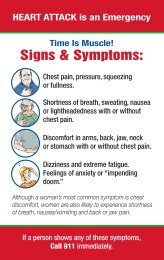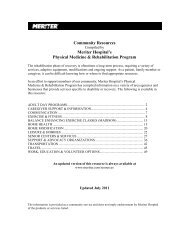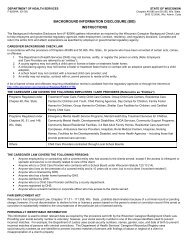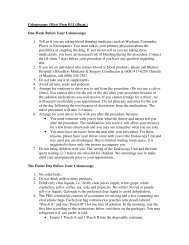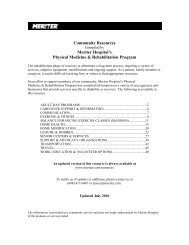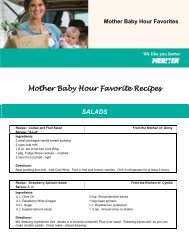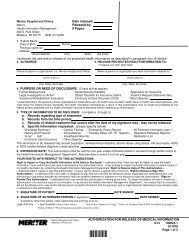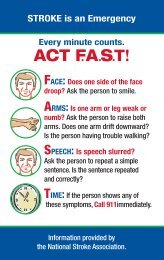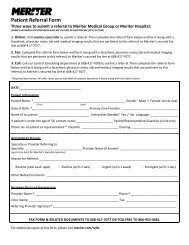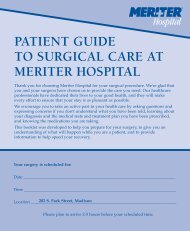A Guide To Your New Family's First Weeks - Meriter Health Services
A Guide To Your New Family's First Weeks - Meriter Health Services
A Guide To Your New Family's First Weeks - Meriter Health Services
You also want an ePaper? Increase the reach of your titles
YUMPU automatically turns print PDFs into web optimized ePapers that Google loves.
Helping <strong>Your</strong> Baby Latch to the Breast<br />
Some babies latch onto the breast easily and know<br />
what to do. Other babies need more assistance.<br />
Properly positioning your baby at the breast can<br />
help you achieve better success when latching.<br />
The cross-cradle and football hold are excellent<br />
positions to experiment with during the first few<br />
days, because you have better control of the latch.<br />
Refer to the diagram showing cross-cradle and<br />
football holds.<br />
When positioning, “wrap your baby around you”<br />
so that you and your baby are close to each other.<br />
Remove bulky blankets and clothing so your baby<br />
will be able to get close. <strong>Your</strong> forearm will be holding<br />
your baby’s body and supporting her weight. <strong>Your</strong><br />
baby’s ear, shoulder and hip should be in a straight<br />
line. Support your baby’s neck and shoulders with the<br />
web between your thumb and index finger. Line up<br />
your baby’s nose (not mouth) with the nipple, and tilt<br />
the head back slightly.<br />
With your other hand, support your breast with your<br />
fingers underneath your breast and your thumb on<br />
top (C – hold) or rotate your hand with your<br />
fingers and thumb on either side of the breast<br />
(U – hold). Use the hold that gently compresses<br />
the breast to match the shape of your baby’s mouth.<br />
<strong>To</strong> illustrate, an adult taking a bite from a sub<br />
sandwich would compress it horizontally to better<br />
match up with their horizontal mouth.<br />
Be sure your fingers are well<br />
behind the areola so your<br />
baby will be able to latch<br />
deeply. Push gently into the<br />
breast with the thumb to help<br />
the nipple point slightly upward<br />
towards the roof of the mouth as your<br />
baby latches.<br />
Stroke your baby’s lips with your nipple until her<br />
mouth is wide open, as if yawning. Timing is<br />
important. As the mouth is open, aim the nipple to<br />
the roof of your baby’s mouth and gently, quickly,<br />
bring your baby onto the breast, with the chin<br />
touching first so that your baby takes the breast<br />
deeply into her mouth. Do this by using your arm<br />
(not just hand or wrist). The nipple is the last part<br />
Photos courtesy of medela.com<br />
of the breast to go into your baby’s mouth. As your<br />
baby’s upper lip covers the nipple and before the<br />
mouth begins to close, pull baby in even closer to get<br />
a good deep latch. The nipple should reach the back<br />
of your baby’s mouth, which will trigger suckling. The<br />
nose should be close or lightly touching the breast.<br />
<strong>Your</strong> baby’s lower jaw does most of the work during<br />
feedings; you should position the lower jaw as far<br />
away from the base of the nipple as possible, with the<br />
chin pressed into the breast. This is an “off-center” or<br />
“asymmetrical” latch.<br />
When properly latched, your baby will have drawn as<br />
much breast tissue into his mouth as possible. Continue<br />
to support your breast gently, as needed, for the<br />
duration of the feeding to maintain a good latch. You<br />
should see a wide latch with the lips turned out. You<br />
should feel a rhythmic tugging sensation of the breast<br />
and will occasionally hear soft swallowing sounds. <strong>Your</strong><br />
baby’s cheeks should appear smooth, without dimpling.<br />
If you are having pain, check to see if your baby’s lips<br />
are turned out. If not, try to gently pull them out or<br />
take your baby off the breast by inserting your finger<br />
into the corner of your baby’s mouth to beak the seal.<br />
Latch again with the mouth open wider. If you are still<br />
having pain, or if your baby is not feeding in the ways<br />
described above, continue to reattach as needed until<br />
your baby latches well. Be consistent—a good latch will<br />
pay off! You will feel more comfortable with feedings<br />
and your baby will get more milk, creating a good milk<br />
supply.<br />
Signs of a Good Latch<br />
• Baby’s mouth is wide open, like a yawn<br />
• The entire areola or as much of the breast tissue as<br />
possible is in the mouth<br />
• Baby’s lips are out, curled around the breast<br />
• Baby’s chin, chest, hips and knees are facing and<br />
touching your body<br />
• Baby’s chin is firm against the breast<br />
• Baby’s nose is close to the breast or lightly<br />
touching it<br />
23



